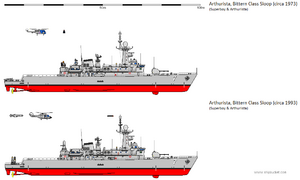Bittern-class sloop
 Bittern-class Sloop
| |
| Class overview | |
|---|---|
| Name: | Flower Class sloop |
| Builders: | Arthuristan Dynamics |
| Operators: | Commonwealth Navy |
| Preceded by: | Black Swan-class sloop |
| Succeeded by: | Flower-class sloop |
| General characteristics | |
| Type: | Sloop-of-war |
| Displacement: | 2,056 tonnes |
| Length: | 97.56m |
| Beam: | 10.97m |
| Draught: | 5.57m |
| Propulsion: | CODAD, 2-shafts, 4x Apollo Motors Wayfarer diesel engine (24,000 shp in total) |
| Speed: | 25kn |
| Range: | 11,000km at 18kn |
| Crew: | 152 |
| Sensors and processing systems: |
|
| Armament: |
|
| Armour: | steel shrapnel sheets, kevlar spall liners |
| Aircraft carried: | Helipad capacity for one light helicopter |
The Bittern-class sloop was a sloop-of-war in service with the Commonwealth Navy. It was replaced in the 2000's by the Flower-class sloop.
The Bittern Class was a response to an urgent fleet requirement, first conceived in the mid-1960's. Surface combatants of the era were specialised vessels designed to protect capital ships and merchant convoys from air and submarine attacks. As the two threats became increasingly sophisticated, platforms designed to ward them off also became progressively more expensive. This had an adverse effect on the number of hulls which could be built. Unfortunately, the Commonwealth Navy maintained a global presence and required large numbers of surface ships to conduct a wide variety of peacetime missions, including general patrols, peacekeeping, anti-piracy operations and 'presence operations' (in other words, 'gunboat diplomacy'). In the aftermath of the Mad Emperor's War and the Liothidian War, large numbers of 40's-era escort ships could be retasked for these missions. As they became increasingly decrepit with age, a replacement became urgently needed.
The 1970's-era Bittern Class was one of the first modern Arthuristan warships designed primarily for peacetime, rather than wartime, requirements. The class inverted normal design practices. The designers' priorities were to minimise costs (acquisition, operational and maintenance) and crew requirements, while maximising endurance and reliability. Rather than possessing state-of-the-art technology in one specialised area, the ships were conferred basic capabilities in a wide variety of roles - surface attack, shore bombardment, anti-submarine warfare and air defence. It was fitted with a 4.5-inch gun which may be used against maritime, air and ground targets, supplemented by 40mm and 20mm autocannons. A Seacat missile launcher provides further air defence. Anti-submarine capabilities were provided by a Limbo mortar system and a depth charge rack. A helicopter deck was installed towards the stern. It was originally envisaged that it would be fitted with either a telescoping hangar, or else become the platform for an anti-submarine missile system, such as a launcher for the Ikara or ASROC. In the event, none of these envisaged additional hardware were ever installed throughout the service life of the class.
Upgrade
The class turned out to be a simple, yet robust and reliable, design which served continuously for more than thirty years. They were always in demand in the Admiralty and, in the mid-1980's to early-1990's, received a number of upgrades. The ineffectual Seacat system was replaced by a Phalanx CIWS, whereas the space originally dedicated to depth charges were used for a quartet of ACM-2 Renove anti-ship missiles instead. In order to retain a degree of anti-submarine capabiliy, a pair of swivelling triple launchers for 324mm lightweight torpedoes were installed.
Numerous Bittern-class vessels remain in mothball after their replacement by the Flower-class.